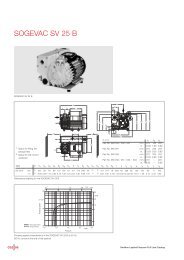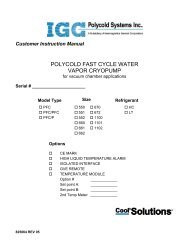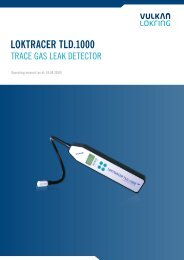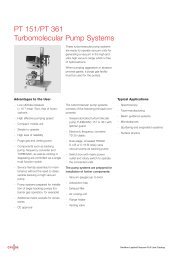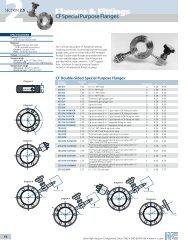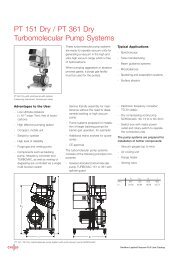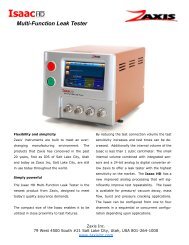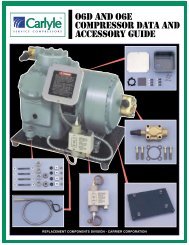B2 - Schoonover, Inc.
B2 - Schoonover, Inc.
B2 - Schoonover, Inc.
You also want an ePaper? Increase the reach of your titles
YUMPU automatically turns print PDFs into web optimized ePapers that Google loves.
Vacuum Gauges<br />
Penning Gauge PEG100<br />
Penning Gauge PEG100<br />
The Penning Gauge PEG100 provides reliable high vacuum<br />
measurements. The rugged penning cold cathode sensor has no<br />
filament to burn out. Due to titanium cathode plates and the reduced<br />
high voltage after plasma ignition, the gauge can be operated also in<br />
sputtering applications. The fieldbus options, in addition to the<br />
logarithmic analog output signal, allow easy integration into vacuum<br />
systems using Profibus DP or DeviceNet protocols.<br />
Patent pending on sensor<br />
Advantages<br />
♦ Wide measurement range from 1 x 10 -9 to 1 x 10 -2 mbar (7.5 x 10 -10<br />
to 7.5 x 10 -3 Torr)<br />
♦ All-metal cold cathode sensor (Penning) with ceramic feedthrough<br />
♦ New electrode geometry provides excellent ignition properties<br />
♦ Decreased high voltage after plasma ignition and titanium cathode<br />
plates reduce risk of contamination, even during sputtering operations<br />
with argon<br />
♦ The anode ring and the titanium cathode can be cleaned or<br />
replaced easily<br />
♦ Minimal magnetic field intensity adjacent to gauge<br />
♦ LED indicator for power on and plasma ignited<br />
♦ Logarithmic analog output signal<br />
♦ Fieldbus interface (Profibus DP, DeviceNet) for easy integration into<br />
vacuum systems using network communications<br />
Typical Applications<br />
♦ High vacuum pressure monitoring<br />
♦ Evaporation and sputtering systems<br />
♦ General vacuum measurement and control in the fine and high<br />
vacuum range<br />
The Penning Gauge PEG100 is a cold cathode sensor based on the well<br />
proven principle of Penning. For degassing of the all-metal sensor with<br />
Al 2<br />
O 3<br />
current feedthrough, the housing of the transmitter with its electronics<br />
and magnet may easily be removed. The magnet offers a closed magnetic<br />
field for negligible stray field. The PEG therefore may also be installed close<br />
to sensitive parts within a system. The anode ring and the titanium cathode<br />
plates may be exchanged easily for quick maintenance should they become<br />
contaminated. Since sputtered titan is not magnetic Ð limiting the build up of<br />
short circuits within the sensor Ð the risk of contamination is greatly<br />
reduced. The newly designed cathode plate acts as a baffle for the sensor.<br />
Fieldbus<br />
Fieldbus allows processes or applications the flexibility and control of<br />
network communications. It permits communication of exact digital<br />
information, independent control, maintenance and diagnostic routines for<br />
each connected instrument and simplifies your connection diagram.<br />
The measures of control include the monitoring of measurement values, the<br />
automatic zero point adjustment of gauges, reminding the operator of<br />
scheduled maintenance work, warning signals in case of instrument failure<br />
and more.<br />
Profibus DP<br />
The central automation systems, e.g. PLC/PC or process control systems,<br />
communicate through a fast serial connection with decentralized<br />
instruments such as I/O, motors, valves and pressure transducers. The<br />
exchange of data with the decentralized instruments takes place mostly in<br />
cycles. The basic functions of the Profibus DP Communication Profile also<br />
include acyclic communication services for parameter setting, controlling,<br />
monitoring, and alert functions of intelligent instruments.<br />
DeviceNet<br />
The DeviceNet interface supports polling, bit strobe and change of<br />
state/cyclic commands. Like with other DeviceNet instruments the user can<br />
monitor and control all available sensor functions.<br />
B6.22






